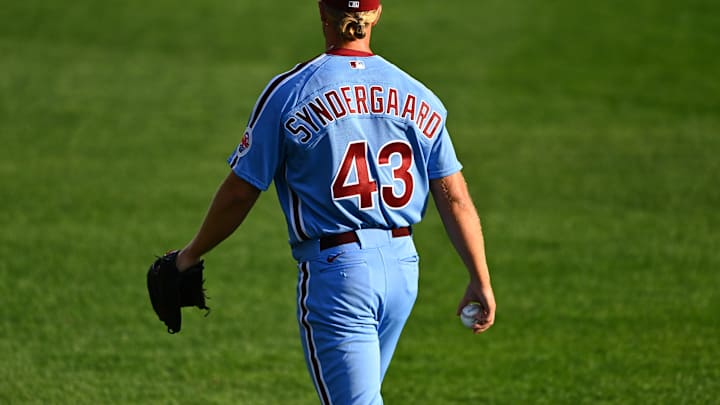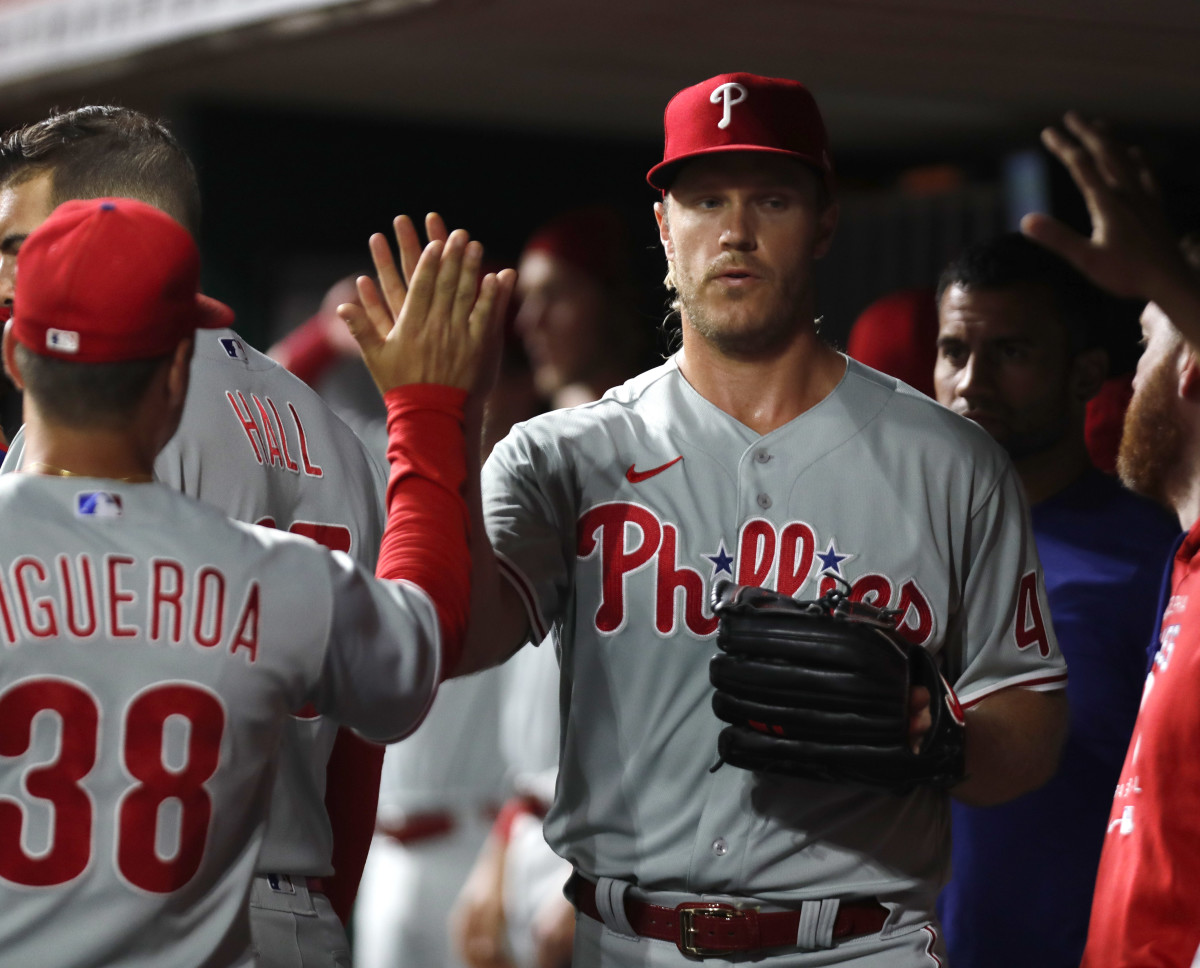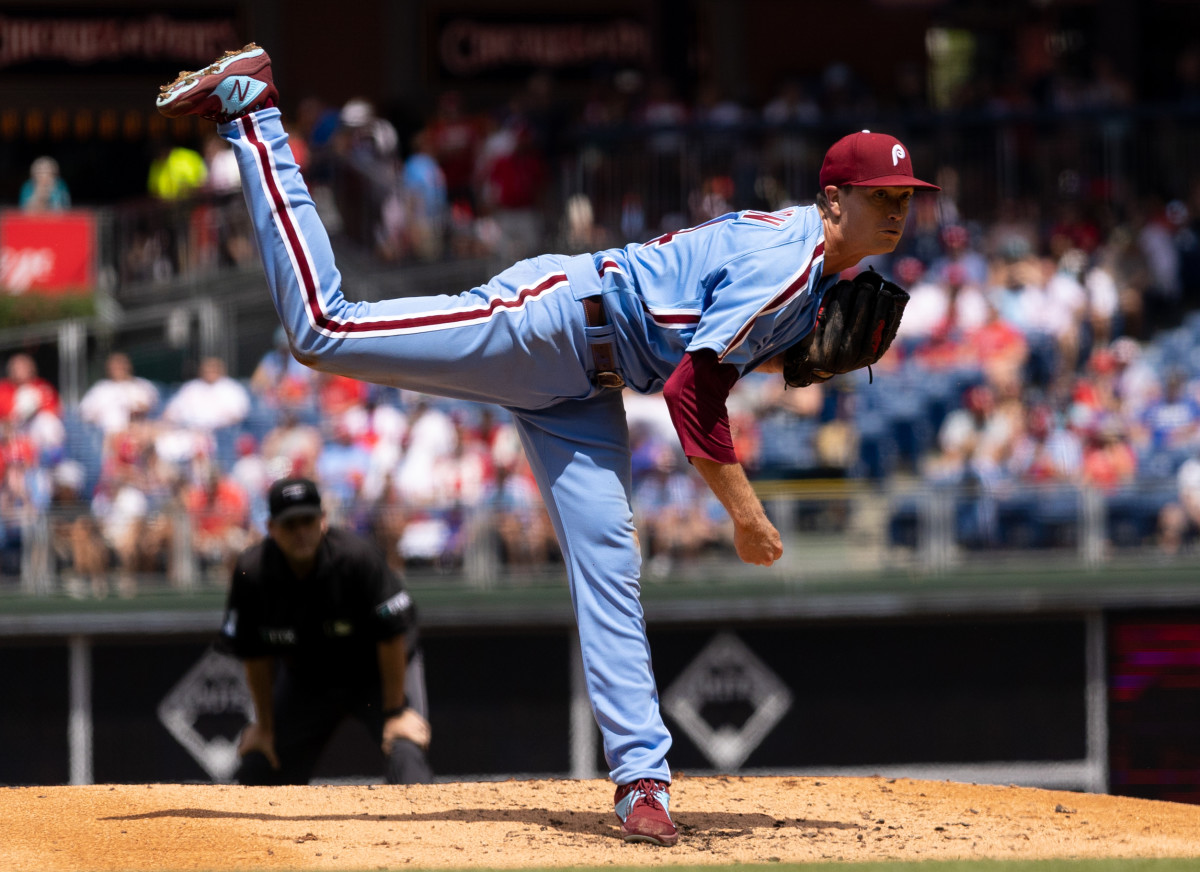Who Would Start Game Four of a Postseason Series for the Phillies?

Despite a few bad losses as of late, the Philadelphia Phillies remain the second National League Wild Card team. If the season ended today, they would face the Atlanta Braves in a best-of-three postseason series.
In such a series, Philadelphia would only need three starters, and hopefully Aaron Nola, Zack Wheeler, and Ranger Suárez would all be rested and ready to go. Were the Phillies to advance in the postseason, however, they would eventually need a fourth starter. And as things currently stand, it's hard to know who that would be.
Noah Syndergaard and Kyle Gibson were both outstanding in their latest starts. Syndergaard threw seven innings, allowing three earned runs and striking out six. Gibson went six innings deep, also giving up three earned runs and striking out eleven.
Overall, the two 6’6” right-handers are performing at a pretty similar level this season. Gibson has made 23 starts, pitching 127.2 innings with a 4.30 ERA. Syndergaard has made fewer starts – just 18, with a total of 98 innings pitched – but with a lower ERA (3.95).
If Philadelphia can advance far enough in the postseason, manager Rob Thomson will have a tough choice on his hands: Gibson or Syndergaard, who starts a potential game four?
The Stats
Looking at the traditional statistics, such as ERA and innings pitched, it's hard to pick between the two options. Gibson has pitched more frequently and consistently, but Syndergaard has been better able to keep runs off the board.
The advanced metrics don't make the decision much easier.
- Gibson: 4.07 xERA, 4.27 FIP, 4.05 xFIP, 4.32 DRA, 3.00 K/BB
- Syndergaard: 4.33 xERA, 3.76 FIP, 4.15 xFIP, 4.61 DRA, 3.17 K/BB
The Statcast data slightly favors Gibson, who allows fewer barrels, while FIP favors Syndergaard and his low home run rate. xFIP, on the other hand, gives a small advantage to Gibson, because he allows fewer fly balls.
Ultimately, all these differences are small. The only real takeaway from these numbers is that the two pitchers are at a pretty similar talent level. Thomson will need to look a lot deeper than the full season stats to make his decision.
Consistency
Gibson and Syndergaard are similarly talented, and over the course of the season, they've ended up with pretty similar stats. But how do they compare on a game-by-game basis?
Neither one is an ace, but both are capable of pitching a great game every so often. Perhaps whoever is more likely to throw a gem should get the nod.

On the other hand, both of these guys have their bad days once in a while too. In the postseason, bad games can be especially detrimental – and should be avoided at all costs.
In other words, consistency is an important factor in naming a playoff starter. Has one of Gibson or Syndergaard been more reliable and consistent this season?
Quality start percentage
- Gibson: 57% (13/23)
- Syndergaard: 39% (7/18)
Gibson has been more likely than Syndergaard to record a quality start on any given day. He has gone at least six innings while allowing three earned runs or fewer in the majority of his starts. That's sounds pretty reliable.
Unfortunately, Gibson is also more likely than Syndergaard to have a bad day. He has failed to make it out of the fifth inning in almost one third of his starts, and he has allowed five or more runs on five occasions.
Starts under 5 IP
- Gibson: 30% (7/23)
- Syndergaard: 22% (4/18)
Starts with ERA over 4.50
- Gibson: 39% (9/23)
- Syndergaard: 28% (5/18)
So, Gibson is more likely to go out and give the team a great start (he has three outings with a game score over 80, while Syndergaard has none), but he is also more likely to implode. He is somehow both the more reliable option and the less reliable option.
Experience
Onto the intangibles.
While both pitchers have played in the postseason, Syndergaard has more experience in October.

Gibson pitched just one inning in relief during the 2019 ALDS (and gave up three runs). Syndergaard, on the other hand, has started four postseason games with a 2.42 ERA. Four starts might not seem like a lot, but compared to the rest of the Phillies' rotation, it is a wealth of experience.
That being said, Gibson has the advantage when it comes to his big league resume. At 34 years old, he has started 253 big league games – almost twice as many as Syndergaard. He has pitched a full season (or close to a full season) in every year since 2014. There are fewer question marks surrounding a guy like him.
This is another close call, but experience might be the ultimate reason Gibson ends up with the ball in game four. Whether it is the right call or not, baseball is a sport that values veteran experience.
Bullpen Capabilities
Whoever is not named the fourth starter is likely to move to the bullpen come October. So when Thomson makes his decision about who starts game four, he will also take into account who would perform better out of the pen.
Kyle Gibson has been particularly good the first time through the opposing order, this year and throughout his career. In 2022, he has a 1.79 ERA and opposing batters are hitting just .204 against him the first time through.
Syndergaard has not been so dominant the first time through the order, but he has been more consistently good throughout games. His numbers the third time through aren't so different from his numbers at any other point. That would seem to make Gibson the better reliever and Syndergaard the better starter.
Yet it is Syndergaard who has more typical bullpen stuff. He throws a harder fastball and his curveball is a strong secondary pitch. Gibson does not throw as fast, and he relies on catching hitters off guard with a wide variety of pitches rather than one elite secondary offering.
Once again, this is a very close call to make, and there are good arguments on either side. The more straightforward solution, however, would be to put Syndergaard in the bullpen, given his natural bullpen stuff.
In Conclusion
Gibson and Syndergaard both make for great fourth starters. The Phillies are lucky to be in a position of choosing between them.
As things currently stand, Gibson probably has the edge to start a potential game four. His veteran experience will be an asset in October, and Syndergaard is the more natural choice to transition to a bullpen role.
There is still plenty of time, however, for things to change. Syndergaard is working with the coaching staff to alter his approach, and if his adjustments pay off he could surpass Gibson on the depth chart.
The next six weeks will play a big role in determining who Philadelphia's fourth starter is. As the season winds down and the Phillies fight for a postseason berth, Gibson and Syndergaard will be in a little battle of their own. Hopefully it lights a fire under both of them to pitch as well as they can down the stretch.
More From SI's Inside The Phillies:
- How Mike Trout Will Join the Phillies
- Why You Should Root for the Philadelphia Phillies to Lose a Few Games
- Have the Philadelphia Phillies Found Their Centerfielder of the Future?
- Could The Phillies Soon Be Playing in Wawa Park?
- 18-Year-Old Phillies Prospect is Making History
- How did Philadelphia end up with Citizens Bank Park?
- How the Phillie Phanatic Came to be America's Favorite Sports Mascot
- This Unlikely Draft Pick Could be the Final Piece in the Phillies Next Blockbuster Trade
- Picking the Phillies' All-Time Single Season Lineup
- Drawing Comparisons to Harper, Phillies Prospect Wilson is Heating Up
Make sure to follow Inside the Phillies on Substack and Twitter!
